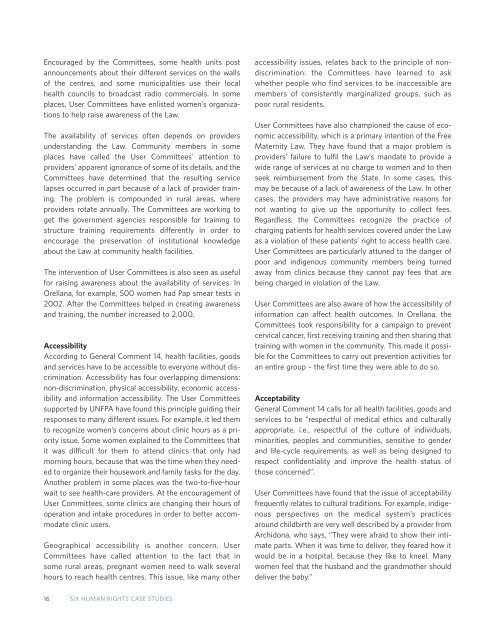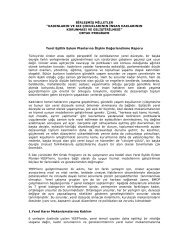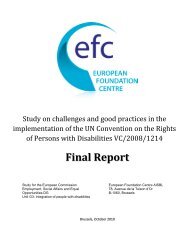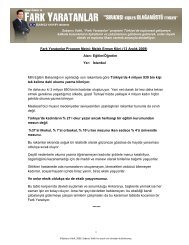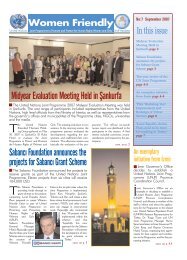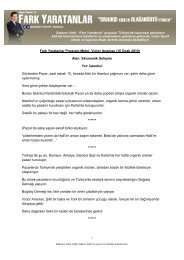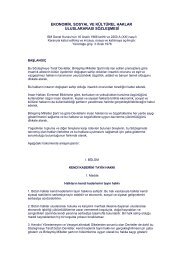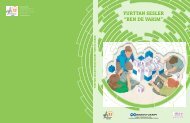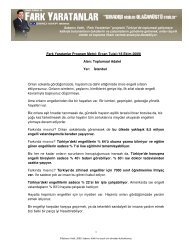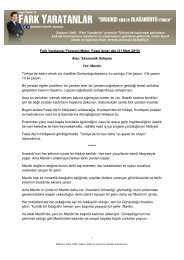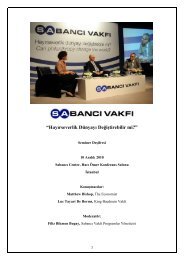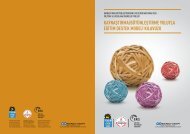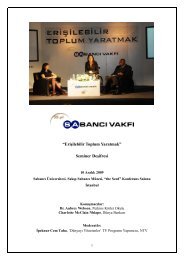UNFPA at Work: Six Human Rights Case Studies
UNFPA at Work: Six Human Rights Case Studies
UNFPA at Work: Six Human Rights Case Studies
- No tags were found...
You also want an ePaper? Increase the reach of your titles
YUMPU automatically turns print PDFs into web optimized ePapers that Google loves.
Encouraged by the Committees, some health units postannouncements about their different services on the wallsof the centres, and some municipalities use their localhealth councils to broadcast radio commercials. In someplaces, User Committees have enlisted women’s organiz<strong>at</strong>ionsto help raise awareness of the Law.The availability of services often depends on providersunderstanding the Law. Community members in someplaces have called the User Committees’ <strong>at</strong>tention toproviders’ apparent ignorance of some of its details, and theCommittees have determined th<strong>at</strong> the resulting servicelapses occurred in part because of a lack of provider training.The problem is compounded in rural areas, whereproviders rot<strong>at</strong>e annually. The Committees are working toget the government agencies responsible for training tostructure training requirements differently in order toencourage the preserv<strong>at</strong>ion of institutional knowledgeabout the Law <strong>at</strong> community health facilities.The intervention of User Committees is also seen as usefulfor raising awareness about the availability of services. InOrellana, for example, 500 women had Pap smear tests in2002. After the Committees helped in cre<strong>at</strong>ing awarenessand training, the number increased to 2,000.AccessibilityAccording to General Comment 14, health facilities, goodsand services have to be accessible to everyone without discrimin<strong>at</strong>ion.Accessibility has four overlapping dimensions:non-discrimin<strong>at</strong>ion, physical accessibility, economic accessibilityand inform<strong>at</strong>ion accessibility. The User Committeessupported by <strong>UNFPA</strong> have found this principle guiding theirresponses to many different issues. For example, it led themto recognize women’s concerns about clinic hours as a priorityissue. Some women explained to the Committees th<strong>at</strong>it was difficult for them to <strong>at</strong>tend clinics th<strong>at</strong> only hadmorning hours, because th<strong>at</strong> was the time when they neededto organize their housework and family tasks for the day.Another problem in some places was the two-to-five-hourwait to see health-care providers. At the encouragement ofUser Committees, some clinics are changing their hours ofoper<strong>at</strong>ion and intake procedures in order to better accommod<strong>at</strong>eclinic users.Geographical accessibility is another concern. UserCommittees have called <strong>at</strong>tention to the fact th<strong>at</strong> insome rural areas, pregnant women need to walk severalhours to reach health centres. This issue, like many otheraccessibility issues, rel<strong>at</strong>es back to the principle of nondiscrimin<strong>at</strong>ion:the Committees have learned to askwhether people who find services to be inaccessible aremembers of consistently marginalized groups, such aspoor rural residents.User Committees have also championed the cause of economicaccessibility, which is a primary intention of the FreeM<strong>at</strong>ernity Law. They have found th<strong>at</strong> a major problem isproviders’ failure to fulfil the Law’s mand<strong>at</strong>e to provide awide range of services <strong>at</strong> no charge to women and to thenseek reimbursement from the St<strong>at</strong>e. In some cases, thismay be because of a lack of awareness of the Law. In othercases, the providers may have administr<strong>at</strong>ive reasons fornot wanting to give up the opportunity to collect fees.Regardless, the Committees recognize the practice ofcharging p<strong>at</strong>ients for health services covered under the Lawas a viol<strong>at</strong>ion of these p<strong>at</strong>ients’ right to access health care.User Committees are particularly <strong>at</strong>tuned to the danger ofpoor and indigenous community members being turnedaway from clinics because they cannot pay fees th<strong>at</strong> arebeing charged in viol<strong>at</strong>ion of the Law.User Committees are also aware of how the accessibility ofinform<strong>at</strong>ion can affect health outcomes. In Orellana, theCommittees took responsibility for a campaign to preventcervical cancer, first receiving training and then sharing th<strong>at</strong>training with women in the community. This made it possiblefor the Committees to carry out prevention activities foran entire group – the first time they were able to do so.AcceptabilityGeneral Comment 14 calls for all health facilities, goods andservices to be “respectful of medical ethics and culturallyappropri<strong>at</strong>e, i.e., respectful of the culture of individuals,minorities, peoples and communities, sensitive to genderand life-cycle requirements, as well as being designed torespect confidentiality and improve the health st<strong>at</strong>us ofthose concerned”.User Committees have found th<strong>at</strong> the issue of acceptabilityfrequently rel<strong>at</strong>es to cultural traditions. For example, indigenousperspectives on the medical system’s practicesaround childbirth are very well described by a provider fromArchidona, who says, “They were afraid to show their intim<strong>at</strong>eparts. When it was time to deliver, they feared how itwould be in a hospital, because they like to kneel. Manywomen feel th<strong>at</strong> the husband and the grandmother shoulddeliver the baby.”16SIX HUMAN RIGHTS CASE STUDIES


